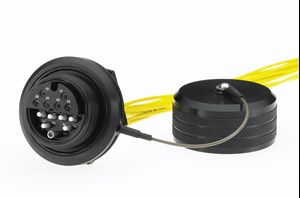24-Fiber ‘quick’ connectors provide optimum solution for multi-channel fiber in explosive atmospheres
ROANOKE, Virginia -- A quick and easy solution can speed the certification of fiber optic cabling installed in explosive atmospheres including caustic marine environments.
As automation continues to expand into diverse industrial sectors, the demand for multi-channel fiber optic cable is following suit. However, there is an increasing need for high-count, high-bandwidth fiber, capable of delivering the ever-increasing amount of data required in a single cable. This requirement is often most pressing in locations where space limitations simply won’t permit installation of extensive runs of low-count fiber, such as offshore platforms.
In addition, for sectors like oil and gas there is a considerable advantage to installing pre-terminated plug-and-play quick connectors that meet the recently-adopted international standards for explosive atmospheres.
As an example, fiber is increasingly being used in upstream exploration and production where land-based rigs are often moved, the ability to quickly change and reconfigure fiber cables can save considerable time and costs. Also, since offshore rigs can’t afford the time and cost of helicoptering in a fiber technician every time a cable requires servicing or replacement, quick-connect/disconnect connectors save on both service and downtime.
Another situation that often requires addressing is the need to make frequent changes to fiber cable configurations or service/replace cable when equipment is damaged. The use of pre-terminated fiber cable connectors that can quickly and easily be plugged in or unplugged can be very useful in both facilitating installation and avoiding prolonged service downtime.
Avoiding explosive hazards
In both offshore and land-based natural gas and oil rigs, multi-channel high-speed fiber optic cable is required to control automation as well as monitor equipment status and communicate predictive notifications when components are in danger of failing. Such capabilities create enormous cost savings by avoiding extended downtime due to catastrophic equipment failures.
Because these hazardous locations include sites with potentially explosive atmospheres, the risk of a catastrophic event should be taken into consideration. According to organizations that establish international safety requirements, the potential for fiber optics to cause ignition of explosive atmospheres presents a real hazard.
In some cases the explosion of flammable materials causes expensive downtime and the repair and/or replacement of equipment; in others the downtime and other costs – including human lives – can be colossal. The cost of a deepwater oil rig today averages around $350 million, and the stoppage of well production can range upward to $375,000 daily.
Because the hazards of explosive atmospheres are a global concern, ATEX (Atmosphere Explosibles) and the IECEx (International Electrotechnical Commission) have issued special “directives” to establish minimum requirements for improving the health and safety of workers potentially at risk. The potential for these standards to be more widely adopted in the future is also likely.
Identifying risks
IECEx has determined that the primary risk of running fiber optic cabling in explosive or potentially-explosive atmospheres is related to the cable connectors, the receptacle that couple fiber optic cable to an enclosure. These are described as potential ignition sources under certain conditions, or “Zones,” as determined by ATEX.
“The primary ATEX zones where fiber optic connectors should be certified as safe are Zone 1 and Zone 2,” says Phillip Hoyle, an expert in fiber optics and product development specialist with Optical Cable Corporation (OCC). “Zone 1 is defined as a place in which an explosive atmosphere is likely to occur in normal operation. Zone 2 applies to locations where an explosion is less likely to occur in normal operation, but if it does occur, will persist for a short period only.”
Hoyle adds that there is actually an enormous number of users that should be using certified connectors in potentially explosive atmospheres. Yet, there is a lack of available certified fiber connector solutions, particularly with high-count multi-channel options that facilitate the bandwidth that is required.
As an example, OCC recently developed the EZ-Mate Ex line of quick connectors, which provides up to 24 fiber connections in a single connector and has hazardous location protection for Zones 1 and 2.
“Having a certified fiber connectors installed in a hazardous area not only speeds up the certification process, but can also reduce time to market along with reduced testing and certification costs for the customer,” he explains.
A speedy solution
“Quick” connectors are an ideal solution for applications that require frequent teardown and setup. “This is highly appropriate for quick disconnect systems that are optimal for areas that need to be taken down or switched out, something that is more mobile,” Hoyle explains. “Each receptacle can be mounted to an increased safety or flame- proof enclosure, allowing for multiple easy connect and disconnect deployments, reducing teardown time.”
Hoyle adds that quick disconnect systems such as the EZ-Mate can be highly beneficial in switching out frequently relocated and reconfigured applications such as land-based rigs as well as more efficiently servicing high damage areas on offshore platforms.
Without a quick connect-disconnect connector if the equipment is damaged and must be moved, or if the cable has to be moved when the rig is moved, the only option is the cut the cable and then re-splice it. However, since most offshore rigs do not have a fiber technician on board, such repairs would mean having to helicopter a service technician to the site, resulting in added costs and downtime.
To make the explosive atmosphere-fiber solution a comprehensive one, manufacturers like OCC work with ATEX/IECEx-certified enclosure manufacturers to provide a complete end-to-end solution.
Such comprehensive solutions will not only ensure safer environments for workers and equipment, but will also make the conversion to directive-compliant explosive atmosphere protection more efficient, with minimal downtime.



